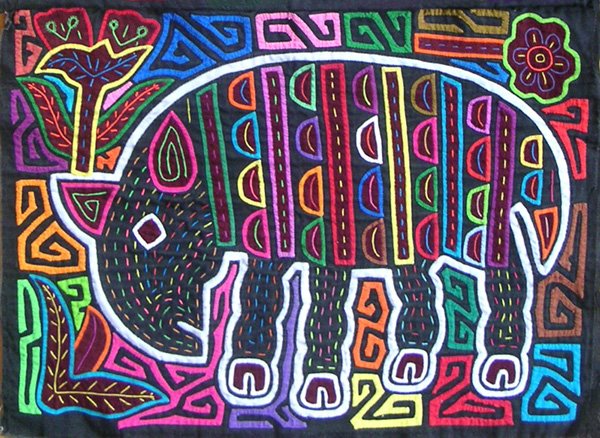
My adventures in Panama do not begin on the San Blas islands where most of the traditional Kuna live. I will be starting my journey in Panama City. A city that is right now the definition of globalization. The fastest growing economy in Latin America. The main part of the city (from what I recall...and through what my local friends have been informing me) is beginning to resemble Miami. But the old part of the city, still shows the beauty of Panama. Casco Viejo. Colorful buildings, chipping paint, cobblestone roads, a real feeling of Latin American culture.
I will be interning with an Agroforestry company. Where a friend of mine has been collecting different species of plants and trees (mostly medicinal) and has been commissioned to re-plant these species. More details will unfold about this complex job of his once I arrive in Panama. But for the time being I have been trying to understand what Agroforestry truly is, and why it is so important. So as I learn, I hope to also inform you....
Tree domestication boosts family income
Farming groups delighted by the success of their nurseries and the income they can generate with their newly-acquired tree domestication skills.
The World Agroforestry Centre tree domestication training programmes in Cameroon, supported by the International Fund for Agricultural Development (IFAD), have generated a lucrative new nursery industry with farmer groups producing their own improved planting materials for agroforestry trees, particularly indigenous fruit and medicinal trees.
For Christophe and Delphine Missé and the other seven members of their farming group, in the village of Lekie-Assi in Cameroon's Centre Province, the nursery in which they are domesticating indigenous trees and improving some valuable exotic species has produced small miracles. "The plants we produce in the nursery have changed our lives," says Delphine Missé. "My husband has been able to build this house, and our eldest daughter who is 12 was able to join secondary school after completing her primary education. The school costs 260 000 CFA (USD 500) a year and it is because of the plants we sell that we can afford that."
The Missé family and the other members of their farming group are delighted by the success of their nursery and the income they can generate with their newly-acquired skills in vegetative propagation, marcotting, grafting and rooting of cuttings techniques. These have allowed them to multiply superior indigenous trees such as safou (Dacryodes edulis), njansang (Ricinodendron heudelotii), Kola nut (Cola spp), and bush mango or Dika nut (Irvingia gabonensis)."This year we earned more from selling plants than we did from our cash crop, cocoa," says the Missé family.
The farmers' group in Lekie-Assi has come a long way in a short time. Six years ago, they were trekking 15 km to a central pilot nursery where the World Agroforestry Centre and its national partners were offering training on vegetative propagation. After they finished their training and mastered the techniques, the Centre helped them establish their own nursery in 2001.
Ebenezar Asaah, the Centre's agroforestry tree domestication specialist, says the Centre began the training on tree propagation techniques in 1998, as part of their participatory tree domestication programme supported by lFAD. They held training sessions for farmer groups, community-based organizations, NGOs, national research institutes and also extension organizations. They began with pilot nurseries in the different ecological zones of Cameroon – two each for the forest and humid savannah zones. These nurseries were to test and evaluate vegetative propagation techniques with farmers, and later to train neighbouring communities on these techniques, nursery management and germplasm collection.
Two years later, off-shoot nurseries began to emerge throughout Cameroon, even in the South Province, where no pilot nursery had been established. These satellite nurseries, in turn, began spawning more nurseries, which now amount to 67 in Cameroon. Richard Ndeugue also recognized the business potential of the nurseries. On the main road between Yaoundé and the western highlands, Ndeugue has put up a shade house, three non-mist propagators and one taller 'humidity chamber' in which he weans marcotts after they have been lopped off a mother tree and potted in polythene bags. In this thriving nursery, established in 2003, Ndeugue earns a healthy income for himself, his family and the six men who work with him.A page from his ledger shows that the group has taken in an impressive 395 400 CFA, about USD 750, from marcotts, rooted cuttings and grafts of a wide range of indigenous and exotic agroforestry trees. "Researchers even come to me from Yaoundé asking for medicinal plants." "Nurseries are good business," says Deman Aseh, another young nursery operator and entrepreneur in the village of Mulombo in Cameroon's mountainous Northwest province. Aseh and his mixed farming group MUMIFAG say that they are generating income not just for themselves but also "for farmers in their community who are now able to plant and grow lucrative and high-quality indigenous trees on their farms".
Aseh has employed his brother full-time in his small shop so he can devote himself to the agroforestry nursery and to the new shop the group has opened on the roadside, to sell the improved planting materials that lay the basis for a new era of farming with high quality agroforestry trees in the humid tropics of Africa.
Source: World Agroforestry Centre, 'Agroforestry in action’ series, document reference 2005-11-Trees and Markets-African Humid Tropics
I will be interning with an Agroforestry company. Where a friend of mine has been collecting different species of plants and trees (mostly medicinal) and has been commissioned to re-plant these species. More details will unfold about this complex job of his once I arrive in Panama. But for the time being I have been trying to understand what Agroforestry truly is, and why it is so important. So as I learn, I hope to also inform you....
Tree domestication boosts family income
Farming groups delighted by the success of their nurseries and the income they can generate with their newly-acquired tree domestication skills.
The World Agroforestry Centre tree domestication training programmes in Cameroon, supported by the International Fund for Agricultural Development (IFAD), have generated a lucrative new nursery industry with farmer groups producing their own improved planting materials for agroforestry trees, particularly indigenous fruit and medicinal trees.
For Christophe and Delphine Missé and the other seven members of their farming group, in the village of Lekie-Assi in Cameroon's Centre Province, the nursery in which they are domesticating indigenous trees and improving some valuable exotic species has produced small miracles. "The plants we produce in the nursery have changed our lives," says Delphine Missé. "My husband has been able to build this house, and our eldest daughter who is 12 was able to join secondary school after completing her primary education. The school costs 260 000 CFA (USD 500) a year and it is because of the plants we sell that we can afford that."
The Missé family and the other members of their farming group are delighted by the success of their nursery and the income they can generate with their newly-acquired skills in vegetative propagation, marcotting, grafting and rooting of cuttings techniques. These have allowed them to multiply superior indigenous trees such as safou (Dacryodes edulis), njansang (Ricinodendron heudelotii), Kola nut (Cola spp), and bush mango or Dika nut (Irvingia gabonensis)."This year we earned more from selling plants than we did from our cash crop, cocoa," says the Missé family.
The farmers' group in Lekie-Assi has come a long way in a short time. Six years ago, they were trekking 15 km to a central pilot nursery where the World Agroforestry Centre and its national partners were offering training on vegetative propagation. After they finished their training and mastered the techniques, the Centre helped them establish their own nursery in 2001.
Ebenezar Asaah, the Centre's agroforestry tree domestication specialist, says the Centre began the training on tree propagation techniques in 1998, as part of their participatory tree domestication programme supported by lFAD. They held training sessions for farmer groups, community-based organizations, NGOs, national research institutes and also extension organizations. They began with pilot nurseries in the different ecological zones of Cameroon – two each for the forest and humid savannah zones. These nurseries were to test and evaluate vegetative propagation techniques with farmers, and later to train neighbouring communities on these techniques, nursery management and germplasm collection.
Two years later, off-shoot nurseries began to emerge throughout Cameroon, even in the South Province, where no pilot nursery had been established. These satellite nurseries, in turn, began spawning more nurseries, which now amount to 67 in Cameroon. Richard Ndeugue also recognized the business potential of the nurseries. On the main road between Yaoundé and the western highlands, Ndeugue has put up a shade house, three non-mist propagators and one taller 'humidity chamber' in which he weans marcotts after they have been lopped off a mother tree and potted in polythene bags. In this thriving nursery, established in 2003, Ndeugue earns a healthy income for himself, his family and the six men who work with him.A page from his ledger shows that the group has taken in an impressive 395 400 CFA, about USD 750, from marcotts, rooted cuttings and grafts of a wide range of indigenous and exotic agroforestry trees. "Researchers even come to me from Yaoundé asking for medicinal plants." "Nurseries are good business," says Deman Aseh, another young nursery operator and entrepreneur in the village of Mulombo in Cameroon's mountainous Northwest province. Aseh and his mixed farming group MUMIFAG say that they are generating income not just for themselves but also "for farmers in their community who are now able to plant and grow lucrative and high-quality indigenous trees on their farms".
Aseh has employed his brother full-time in his small shop so he can devote himself to the agroforestry nursery and to the new shop the group has opened on the roadside, to sell the improved planting materials that lay the basis for a new era of farming with high quality agroforestry trees in the humid tropics of Africa.
Source: World Agroforestry Centre, 'Agroforestry in action’ series, document reference 2005-11-Trees and Markets-African Humid Tropics

